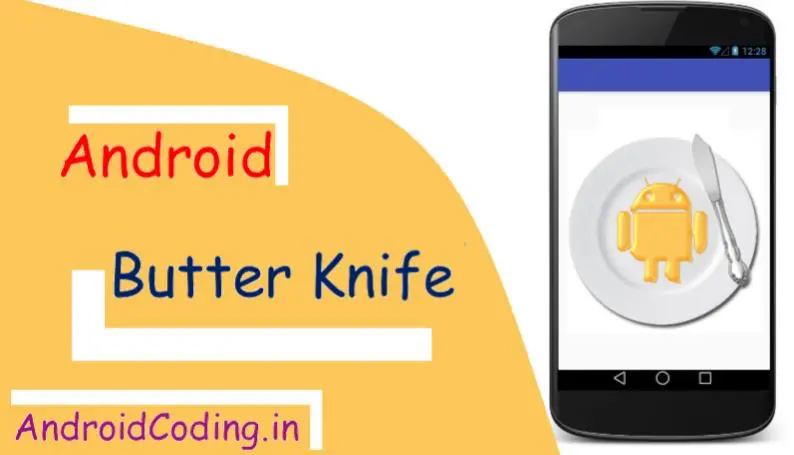Android ButterKnife :
An easier and simple way to bind UI components in the android screens to the code is explained with the help of butterknife android i.e., butterknife tutorial.
Butter Knife is one of the type of view injection’s available in the coding terminology which uses annotation processing. Let’s get started to our Android Tutorial on ButterKnife || ButterKnife Tutorial || Data Binding
Generally its a good practice to use this kind of data binding which make you coding much flexible, easier and even faster compared to the older methodologies.Not only Butter Knife we have other data binding’s which we will discuss in coming tutorials.
Not only UI components but we can bind several other category’s like
1) Binding View’s ( @BindView ) –> TextView, Button, Edittext, Checkbox.. and other UI Components
2) Binding String’s (@BindString ) –> Bind Strings from strings.xml file
3) Binding Drawables ( @BindDrawable ) –> Bind drawable images from drawable folder.
4) Binding Color’s( @BindColor ) –> Bind color from color.xml
5) Binding Dimen’s( @BindDimen ) –> Bind dimension from dimen.xml file
Add Butter Knife library to your android studio project
I am using 8.6.0 version check latest version before you add android butterknife plugin
implementation 'com.jakewharton:butterknife:8.6.0' annotationProcessor 'com.jakewharton:butterknife-compiler:8.6.0'
[/et_pb_text][et_pb_text admin_label=”Text” background_layout=”light” text_orientation=”left” use_border_color=”off” border_color=”#ffffff” border_style=”solid”]
The traditional way of binding views to code is as
for example textview :
TextView txtView = (TextView) findViewById(R.id.txt_view);
( or )
TextView txtView = findViewById(R.id.txt_view);
which is initialized as following way using android butterknife bindview
@BindView(R.id.txt_view) TextView txtView;
Here we are binding the view using @BindView as discussed above it’s a view component so we are using BindView.
Also if we include any layout in the view we can initialize them as the above way compared to traditional style where we used to add view before like
TextView txtView = view.findViewById(R.id.txt_view);
which is initialized as same way we initialize a local view using android butterknife
@BindView(R.id.txt_view) TextView txtView;
But the most important crucial step in Android ButterKnife is to initialize it before using it in activity, fragment where ever you use it as
In activity’s we pass the activity parameter as “this”
ButterKnife.bind(this);
In Fragment’s we pass Object “this” and Source “view”
ButterKnife.bind(this,view);
Bind Different views as
Activity.Java
In onCreate() method initialize Android ButterKnife “butter injection” first for reference i am specifying imports.
import butterknife.ButterKnife;
ButterKnife.bind(this);
then
import butterknife.BindColor; import butterknife.BindDimen; import butterknife.BindDrawable; import butterknife.BindString; import butterknife.BindView;
@BindView(R.id.btn_click) Button btnClick; @BindView(R.id.txt_view) TextView txtView; @BindView(R.id.img_view) ImageView imgView; @BindString(R.string.mysite) String showText; @BindDrawable(R.drawable.sampleimg) Drawable sampleImg; @BindColor(R.color.colorPrimaryDark) int colorPrimaryDark; @BindDimen(R.dimen.txtSize) Float txtSize;
then set their values android onclick
btnClick.setOnClickListener(this); // set android button onclick txtView.setText(showText); // Set string using butterknife txtView.setTextSize(txtSize); // Set text size using butterknife txtView.setTextColor(ContextCompat.getColor(this, colorPrimaryDark)); // Set textcolor using butterknife imgView.setImageDrawable(sampleImg); // Set image using butterknife
for button click
@Override
public void onClick(View v) {
switch(v.getId()){
case R.id.btn_click:
Toast.makeText(this, "Clicked here", Toast.LENGTH_SHORT).show();
break;
}
}
Fragment.java
In OnCreate() initialize the Android ButterKnife which is a slightly different from Activity we pass an extra parameter – android fragment example
ButterKnife.bind(this,view);
The initialization of views is same as activity
@BindView(R.id.txt_view) TextView txtView; @BindString(R.string.mysite) String showText;
then you can use it as
txtView.setText(showText);
Now i would like to show usage of Butter knife in a BaseAdapter file
In ViewHolder class we initialize views so here is the way we don using Butter Knife
static class ViewHolder {
@BindView(R.id.txt_view)
TextView txtView;
public ViewHolder(View view) {
ButterKnife.bind(this, view);
}
}
And as you expect the usage is same as where we use holder object to set values to it
holder.txtView.setText("AndroidCoding.in");
SampleAdapter.java
butter knife holder
@Override public View getView(int position, View view, ViewGroup parent) {
ViewHolder holder;
if (view != null) {
holder = (ViewHolder) view.getTag();
} else {
view = layoutInflater.inflate(R.layout.sample_adapter, parent, false);
holder = new ViewHolder(view);
view.setTag(holder);
}
holder.txtView.setText("AndroidCoding.in");
return view;
}
static class ViewHolder {
@BindView(R.id.txt_view)
TextView txtView;
public ViewHolder(View view) {
ButterKnife.bind(this, view);
}
}
AndroidManifest.xml
No special permissions are required for using Butter Knife.
If you have any query on this tutorial on Android ButterKnife do let us know in the comment section below.
Do share, subscribe, comment and like our tutorials to get more interesting updates.
